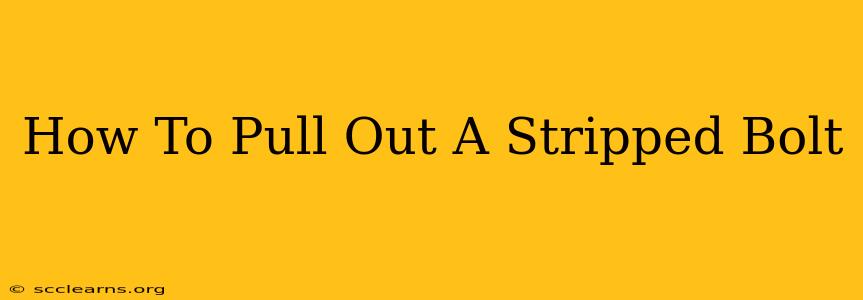So, you've got a stripped bolt. It's frustrating, it's common, and it can bring even the most experienced DIYer to a standstill. But don't despair! This comprehensive guide will walk you through various methods to extract that stubborn bolt, from simple tricks to more advanced techniques. We'll cover everything you need to know to get the job done right, saving you time, money, and a lot of headaches.
Understanding the Problem: Why Bolts Strip
Before diving into solutions, let's briefly understand why bolts strip in the first place. This knowledge helps you avoid similar problems in the future. Common causes include:
- Over-tightening: This is the most frequent culprit. Using excessive force when tightening a bolt can easily damage the threads.
- Corrosion: Rust and corrosion weaken the bolt and its threads, making them more susceptible to stripping.
- Damaged Threads: Pre-existing damage to the bolt or the receiving hole can make stripping more likely.
- Incorrect Tool Use: Using the wrong size or type of socket or wrench can also lead to stripped bolts.
Methods for Removing Stripped Bolts
Now, let's get to the heart of the matter: removing that pesky stripped bolt. Here's a breakdown of effective methods, ranging from simple to more advanced:
1. Using a Bolt Extractor Set
This is often the most effective method, especially for significantly stripped bolts. Bolt extractors are specialized tools with reverse threads that grip into the stripped bolt and unscrew it.
- How it works: Drill a pilot hole into the center of the stripped bolt. Then, screw the extractor into the hole. The extractor's reverse threads will grip the bolt and allow you to turn it out.
- Important Note: Choose the correct size extractor for your bolt. Using too small of an extractor can damage the bolt further; using too large can strip the extractor itself.
2. Applying Penetrating Oil
This simple yet effective step should be your first line of defense. Penetrating oils like PB Blaster or Liquid Wrench can loosen rusted or stuck bolts. Apply generously and allow it to sit for several hours, or even overnight, for best results.
3. Using Vise Grips or Pliers
If the bolt head is still somewhat intact, you might be able to grip it with vise grips or pliers. This method requires care to avoid further damage to the bolt or surrounding area.
4. Drilling Out the Bolt
This is a more destructive method, but it's sometimes necessary. You'll need a drill bit slightly smaller than the bolt's diameter. Carefully drill out the bolt, ensuring you drill straight to avoid damaging surrounding parts.
5. Using an Easy-Out Tool
Similar to bolt extractors, easy-out tools are designed to remove stripped bolts. They often have a more aggressive design and can be effective when other methods fail. However, they also carry a slightly higher risk of damaging the surrounding material.
Prevention is Key: Tips for Avoiding Stripped Bolts
Preventing stripped bolts is far easier than removing them. Here are some preventative measures:
- Use the correct size socket or wrench: Avoid using tools that are too small or too large.
- Apply lubricant: Use lubricant (like WD-40 or similar) before tightening bolts.
- Don't over-tighten: Use a torque wrench to ensure you're not applying excessive force.
- Keep your tools in good condition: Make sure your tools are not worn or damaged.
Conclusion
Dealing with a stripped bolt can be frustrating, but with the right tools and techniques, you can overcome this common mechanical challenge. Remember to choose the appropriate method based on the severity of the stripping and your comfort level with tools. And always remember, prevention is the best cure! By following the preventative tips, you'll significantly reduce the chances of encountering this problem in the future.

